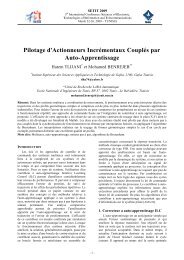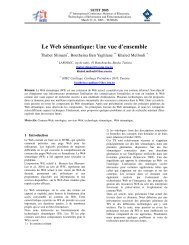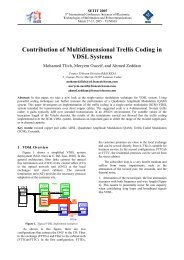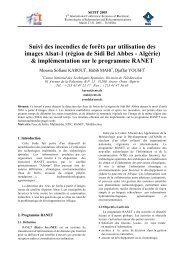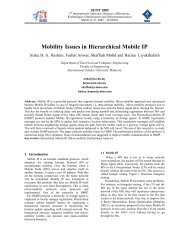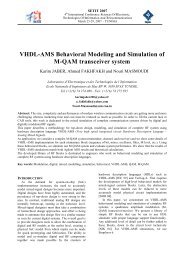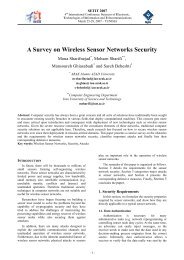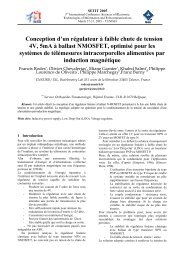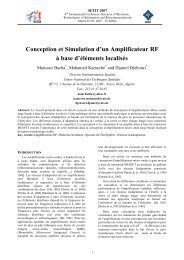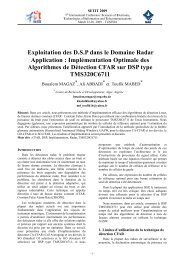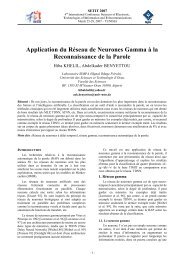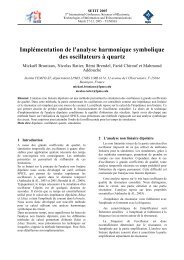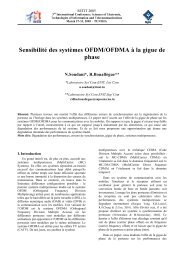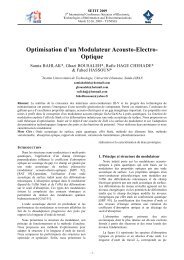Design of a Dual-Band Microstrip Patch Antenna for GSM/UMTS/ISM ...
Design of a Dual-Band Microstrip Patch Antenna for GSM/UMTS/ISM ...
Design of a Dual-Band Microstrip Patch Antenna for GSM/UMTS/ISM ...
Create successful ePaper yourself
Turn your PDF publications into a flip-book with our unique Google optimized e-Paper software.
SETIT 2009<br />
5 th International Conference: Sciences <strong>of</strong> Electronic,<br />
Technologies <strong>of</strong> In<strong>for</strong>mation and Telecommunications<br />
March 22-26, 2009 – TUNISIA<br />
<strong>Design</strong> <strong>of</strong> a <strong>Dual</strong>-<strong>Band</strong> <strong>Microstrip</strong> <strong>Patch</strong> <strong>Antenna</strong> <strong>for</strong><br />
<strong>GSM</strong>/<strong>UMTS</strong>/<strong>ISM</strong>/WLAN Operations<br />
Said GHNIMI*, Adnen RAJHI* and Ali GHARSALLAH*<br />
*Unité de recherche Circuits et Systèmes Electroniques Haute Fréquences, Faculté des sciences de Tunis<br />
said.ghnimi@fst.rnu.tn<br />
adnen.Rajhi@esti.rnu.tn<br />
ali.gharsallah@fst.rnu.tn<br />
Abstract: This paper describes the design <strong>of</strong> a dual-frequency antenna <strong>for</strong> <strong>GSM</strong> and <strong>UMTS</strong>/LAN/<strong>ISM</strong> system<br />
applications. A patch antenna with rectangular aperture is designed by using a thick substrate in order to increase the<br />
bandwidth. After this, we have extracted the reflection coefficient <strong>of</strong> the considered antenna excited by a probe feed and<br />
by optimizing the antenna dimensions and the aperture position. The simulation <strong>of</strong> this antenna has been made by<br />
advanced design system (ADS) in the band <strong>of</strong> frequency between 50 Hz and 3.2 GHz, leading to three resonant<br />
frequencies and showing a good impedance bandwidth per<strong>for</strong>mance to cover the required bandwidth <strong>of</strong> the <strong>GSM</strong> (890–<br />
960 MHz), <strong>UMTS</strong> (1920–2170MHz) and WLAN/<strong>ISM</strong> (at 2.45GHz) bands.<br />
Key words: <strong>Microstrip</strong> patch <strong>Antenna</strong>, dual-band, <strong>GSM</strong>, <strong>UMTS</strong>, <strong>ISM</strong> and WLAN.<br />
INTRODUCTION<br />
In the last few years the Global System <strong>for</strong> Mobile<br />
communications (<strong>GSM</strong>) [RAM 03], the Universal<br />
Mobile Telecommunications System (<strong>UMTS</strong>) bands<br />
[HOL 01] [SUR 06] [HUB 00], and one <strong>of</strong> the <strong>ISM</strong><br />
bands is at 2.45 GHz which is also the same band <strong>for</strong><br />
the Wireless Local Area Network (WLAN) system and<br />
Bluetooth applications have been presented in the<br />
published papers [LIU 07] [LEE 97] [MAL 03].<br />
In the literature, several antennas have been<br />
used in a variety <strong>of</strong> applications <strong>for</strong> which new and<br />
more restrictive requirements in the design <strong>of</strong> the<br />
antenna have been introduced. In particular, <strong>for</strong> highprecision<br />
<strong>GSM</strong>, <strong>UMTS</strong> and <strong>ISM</strong>/WLAN applications,<br />
few solutions have been proposed by [CHA 02]<br />
[TUN 02] [CIA 03]. Un<strong>for</strong>tunately, these solutions, it<br />
may easily provide the desired electric characteristics,<br />
but it becomes impractical due to the operational<br />
requirements on size and weight.<br />
The complicated geometry <strong>of</strong> these various<br />
antennas presents the problem at the levels <strong>of</strong> the<br />
realization, which require very sophisticated<br />
equipments and a higher cost <strong>for</strong> the designer, and <strong>for</strong><br />
the integration <strong>of</strong> these antennas in some applications<br />
such as the base station <strong>of</strong> mobile communication.<br />
- 1 -<br />
The proposed antenna presents a simple technique;<br />
indeed, the use <strong>of</strong> a simple substrate <strong>of</strong> low cost and<br />
larger height allows a good impedance matching; then,<br />
it is necessary to sweep on the dimension <strong>of</strong> the<br />
antenna L, W and the aperture size, and the<br />
juxtaposition <strong>of</strong> the feed probe position allows us to<br />
create new resonant frequencies. Once the dimensions<br />
<strong>of</strong> the resonant antenna are determined, the simulated<br />
coefficient <strong>of</strong> reflection S11 is extracted.<br />
Furthermore, in order to satisfy the demanded<br />
precision and reliability, <strong>for</strong> a high per<strong>for</strong>mance<br />
proposed antenna a simple modification on the patch<br />
surface has been introduced.<br />
The organization <strong>of</strong> this paper is as follows,<br />
section 1, the design <strong>for</strong> the proposed dual-band<br />
rectangular patch antenna is presented, in section 2;<br />
we present results and discussions <strong>for</strong> the per<strong>for</strong>mance<br />
<strong>of</strong> the proposed antenna. Section 3, contains<br />
conclusions, and recommendations <strong>for</strong> further studies.<br />
1. <strong>Antenna</strong> <strong>Design</strong><br />
The geometry <strong>of</strong> the proposed dual-band antenna<br />
is based on the microstrip antenna technique which is<br />
the most popular because <strong>of</strong> the ease <strong>of</strong> analysis and<br />
fabrication and having attractive radiation
SETIT2009<br />
characteristics, it consists <strong>of</strong> a rectangular metallic<br />
patch with a rectangular slot mounted on a grounded<br />
substrate as shown in figure 1.<br />
This microstrip antenna is low-pr<strong>of</strong>ile<br />
con<strong>for</strong>mable to planar surfaces, simple and<br />
inexpensive to fabricate using the modern printed<br />
circuit technology and it can be used in many<br />
applications such as the phased array <strong>for</strong> mobile<br />
telecommunication base station. Due to these<br />
advantageous characteristics <strong>of</strong> the proposed<br />
microstrip antenna, further studies and analysis has<br />
been made in this paper.<br />
Figure 1. Geometry <strong>of</strong> the dual-band microstrip<br />
patch antenna.<br />
For its simple structure, the new antenna can<br />
be easily simulated by advanced design system (ADS)<br />
simulator. Some useful guidelines <strong>for</strong> the antenna<br />
design will be discussed as follows.<br />
The structure used in the simulation to<br />
investigate the due to RF pulses is showed in Figure. 1<br />
where a simple microstrip patch antenna was made<br />
with plexy-glass material (εr =2.55), the thickness <strong>of</strong><br />
the patch is assumed negligible and the height h <strong>of</strong> the<br />
substrate is taken equal to 2.5 cm.<br />
The effects <strong>of</strong> the medium and the fringing<br />
fields at each end <strong>of</strong> the patch are accounted <strong>for</strong> by the<br />
effective relative dielectric constant, εeff, and the edge<br />
extension, ∆L, being the effective length to which the<br />
fields fringe at each end <strong>of</strong> the patch. The following<br />
effective dielectric constant <strong>for</strong>mula proposed is used<br />
in equation 1<br />
1<br />
−<br />
2<br />
ε r + 1 ε r −1<br />
h<br />
ε eff = + ( 1+<br />
12 ) (1)<br />
2 2 W<br />
- 2 -<br />
With<br />
∆L<br />
=<br />
h<br />
And<br />
0,<br />
412<br />
( ε<br />
( ε<br />
r<br />
eff<br />
eff<br />
W<br />
+ 0,<br />
3)(<br />
+ 0,<br />
264)<br />
h<br />
W<br />
− 0,<br />
258)(<br />
+ 0,<br />
8)<br />
h<br />
r<br />
eff<br />
(2)<br />
λ C c0<br />
L = = =<br />
(3)<br />
2 2 f 2 f ε<br />
In general, the resonant frequency <strong>of</strong> rectangular<br />
patch antennas is calculated by using resonant length<br />
transmission line or cavity models, together with<br />
equations <strong>for</strong> the effective dielectric constant and edge<br />
extension from the literature. The resonant frequency<br />
fmn <strong>of</strong> a rectangular patch <strong>of</strong> width W and length L,<br />
both comparable to λs /2, where λs is the wavelength<br />
in the substrate, is given by<br />
f<br />
mn<br />
2<br />
2<br />
c ⎡⎛<br />
⎞ ⎤<br />
0 m ⎛ n ⎞<br />
= ⎢<br />
⎜<br />
⎟ +<br />
⎜<br />
⎟ ⎥<br />
2 ε ⎢⎣<br />
⎝ L<br />
eff e ⎠ ⎝We<br />
⎠ ⎥⎦<br />
(4)<br />
Where εeff is the effective relative dielectric<br />
constant <strong>for</strong> the patch, m and n take integer values,<br />
and Le and We are the effective dimensions.<br />
L e<br />
The effective length Le can be defined as follows:<br />
= L + 2 ∆L<br />
(5)<br />
In order to determine the resonant frequency, the<br />
band <strong>of</strong> use <strong>of</strong> this antenna is defined by:<br />
Fmax<br />
− Finf<br />
B(%)<br />
= 100<br />
(6)<br />
F<br />
r<br />
The dimensions <strong>of</strong> the proposed patch are the<br />
width W= 8cm and the length L=8.55 cm, with a<br />
copper plane on one side; in the patch, a slot is<br />
designed with a length equal to y2-y1 = 4cm and a<br />
width x0 = 0.4cm, the distance between the probe feed<br />
and the slot is d=y1-y0. The coaxial feed was excited<br />
by RF source with impedance <strong>of</strong> 50 Ohms, and the<br />
frequency band <strong>of</strong> analysis ranges the antenna from<br />
electrically short at the lowest frequency to electrically<br />
long at the highest frequency.
SETIT2009<br />
2. Results and discussion<br />
A prototype <strong>of</strong> the antenna has been tested by<br />
ADS simulator, with the above given geometrical<br />
dimensions <strong>of</strong> the patch. The simulation returns loss <strong>of</strong><br />
this antenna is presented in figure 2 <strong>for</strong> three different<br />
distances between the probe feed and the slot edge<br />
(d1=0.01mm d2=1cm, d3=2cm).<br />
Return loss[dB]<br />
0<br />
-5<br />
-10<br />
-15<br />
-20<br />
-25<br />
-30<br />
-35<br />
-40<br />
-45<br />
<strong>GSM</strong> band<br />
S11<br />
d1<br />
d2<br />
d3<br />
<strong>UMTS</strong> band<br />
0.5 1 1.5 2 2.5 3<br />
x 10 9<br />
Frequency[Hz]<br />
Figure 2. Comparisons <strong>of</strong> the simulated return loss <strong>of</strong><br />
the microstrip patch antenna <strong>for</strong> different distances<br />
(d1=0.01mm d2=1cm, d3=2cm).<br />
From this simulation we found dual bands, the first<br />
is around a resonant frequency Fr1 and the second<br />
band can be considered as around two resonant<br />
frequencies (Fr2, Fr3), and it demonstrates that a<br />
good input match has been obtained <strong>for</strong> both the<br />
<strong>GSM</strong>/<strong>UMTS</strong> bands and LAN/<strong>ISM</strong> operations. The<br />
optimal proposed antenna is <strong>for</strong> d2=1cm which covers<br />
the required bandwidth respectively <strong>of</strong> the <strong>GSM</strong> 900,<br />
<strong>UMTS</strong> 2000 bands and <strong>ISM</strong>/WLAN 2450 operations.<br />
For <strong>GSM</strong> 900, a wide operating frequency range <strong>of</strong><br />
890 to 995 MHz is obtained, and the impedance<br />
bandwidth determined from -10 dB return loss can<br />
reach 105 MHz (or 11.37 % referenced to 923 MHz).<br />
For <strong>UMTS</strong> 2000, a much wider operating frequency<br />
range <strong>of</strong> 1900 to 3100 MHz can be obtained, and the<br />
impedance bandwidth determined from -10 dB return<br />
loss can even reach 1200 MHz (or 55.88 % referenced<br />
to 2150 MHz).<br />
The simulation results are summarized in the<br />
table’s 1-3.<br />
Type<br />
d’antenne<br />
Central<br />
d1 d2 d3<br />
frequency<br />
Fr1GHz<br />
0.921 0.923 0.921<br />
BP [%] 10.74 11.37 9.66<br />
Table 1. <strong>Band</strong>width around Fr1<br />
- 3 -<br />
Table 1, present the bandwidth around the first<br />
Fr1 resonance frequency and it is noted that the<br />
resonant frequency Fr1 and the bandwidth are almost<br />
the same one <strong>for</strong> the different distances d.<br />
Table 2. <strong>Band</strong>width around Fr2<br />
Table 3. <strong>Band</strong>width around Fr3<br />
Table 2 and Table 3, present respectively the<br />
bandwidth around the resonance Fr2 and Fr3<br />
frequency, and it is noted that the bandwidth depends<br />
on the distance d. Indeed, one notes <strong>for</strong> d= 1cm the<br />
microstrip patch antenna present a large bandwidth<br />
and more per<strong>for</strong>mance around resonance frequency.<br />
By analyzing the ADS Simulation results <strong>of</strong> the<br />
reflection coefficient <strong>of</strong> the proposed antenna, we can<br />
conclude that the antenna has three resonant<br />
frequencies (Fr1, Fr2, and Fr3); and <strong>for</strong> the different<br />
distances, the frequency Fr1 is almost the same, but<br />
the other frequencies Fr2 and Fr3 changes by<br />
changing the distance d.<br />
The resonant frequency Fr1 given by (7) can be<br />
calculated from the fundamental TM10 mode <strong>of</strong> the<br />
patch antenna with the dimensions (W = 8cm, L =<br />
8.55 cm), to intend <strong>GSM</strong> band.<br />
F<br />
r1<br />
Type<br />
d’antenne<br />
Central<br />
d1 d2 d3<br />
frequency<br />
Fr2GHz<br />
2.25 2.15 2.16<br />
BP [%] 47.55 55.88 28.37<br />
Type<br />
d’antenne<br />
Central<br />
d1 d2 d3<br />
frequency<br />
Fr3GHz<br />
2.74 2.97 2.85<br />
BP [%] 39.05 40.4 17.54<br />
c0<br />
= f10<br />
=<br />
(7)<br />
2L<br />
ε<br />
e<br />
eff<br />
In order to investigate the dependence at the<br />
second resonant frequency Fr2 and at the third<br />
resonant frequency Fr3 according to the different<br />
values <strong>of</strong> d which represent the distance between the<br />
probe feed and the slot, figure.3 and figure.4 are<br />
presented to explain this dependence.
SETIT2009<br />
Fr2[GHz]<br />
Fr3[GHz]<br />
2.28<br />
2.26<br />
2.24<br />
2.22<br />
2.2<br />
2.18<br />
2.16<br />
2.14<br />
0 0.2 0.4 0.6 0.8 1<br />
d[cm]<br />
1.2 1.4 1.6 1.8 2<br />
3<br />
2.95<br />
2.9<br />
2.85<br />
2.8<br />
2.75<br />
Figure 3. Effect <strong>of</strong> the distance d on resonance<br />
frequency Fr2<br />
2.7<br />
0 0.2 0.4 0.6 0.8 1<br />
d[cm]<br />
1.2 1.4 1.6 1.8 2<br />
Figure 4. Effect <strong>of</strong> the distance d on resonance<br />
frequency Fr3<br />
Figure.3 and Figure.4 show how the both<br />
resonances frequencies Fr2 and Fr3, depend<br />
respectively from the distance d between the slot and<br />
the probe feed, indeed, these variations <strong>of</strong> Fr2 and Fr3<br />
have inverse behaviors if Fr2 increases then Fr3<br />
decreases and vice versa.<br />
3. Conclusion<br />
The main quality <strong>of</strong> the proposed antenna is that it<br />
allows an effective design maintaining all the<br />
advantages <strong>of</strong> microstrip antennas in terms <strong>of</strong> size,<br />
weight and easy manufacturing. Moreover, this<br />
antenna has a good effectiveness on the totality <strong>of</strong> the<br />
three covered respectively, <strong>GSM</strong>, <strong>UMTS</strong> and<br />
WLAN/<strong>ISM</strong> frequency bands. This work has to be<br />
studied further to have more precise expressions <strong>for</strong><br />
- 4 -<br />
the dependence <strong>of</strong> Fr2 and Fr3 with the distance d<br />
between the slot and the feed probe.<br />
REFERENCES<br />
[RAM 03] Rammal, M.; Abou Chahine, S.; Fadlallah, N,<br />
“An improved FDTD design <strong>of</strong> a wideband <strong>GSM</strong> patch<br />
antenna”, Proceedings <strong>of</strong> the Twentieth National Radio<br />
Science Conference, March 2003, pp.B17 - 1-5.<br />
[HOL 01] H. Holma and A. Toskala, “WCDMA <strong>for</strong> <strong>UMTS</strong>:<br />
Radio Access <strong>for</strong> Third Generation Mobile<br />
Communications”, John Wiley & Sons, New York,<br />
2001.<br />
[SUR 06] E. Surducan, D.S.Iancu, V.Surducan, J.Glossner,<br />
“<strong>Microstrip</strong> composite antenna <strong>for</strong> multiple<br />
Communication protocols”, International Journal <strong>of</strong><br />
Microwave and Optical Technology, (IJMOT 2006-5-30)<br />
Vol-I-No.2, 2006, pp.772-775, ISSN 1553-0396.<br />
[HUB 00] J.F. Hubner, D. Weiler, H. Brand, “<strong>UMTS</strong>, the<br />
Mobile Multimedia Vision <strong>for</strong> IMT-2000: A Focus on<br />
Standardization”, IEEE Communication Magazine,<br />
September 2000, pp. 129-136.<br />
[LIU 07] Juan Liu, Jing Xia, Gang Wang,“A <strong>Dual</strong>-<strong>Band</strong><br />
<strong>Microstrip</strong>-Fed Bow-Tie <strong>Antenna</strong> <strong>for</strong> <strong>GSM</strong>/CDMA and<br />
3G/WLAN”, IEEE 2007 International Symposium on<br />
Microwave, <strong>Antenna</strong>, Propagation, and EMC<br />
Technologies For Wireless Communications, Aug. 2007,<br />
pp.504-507.<br />
[LEE 97] K.F. Lee, et al., “Experimental and Simulation<br />
Studies <strong>of</strong> the Coaxially Fed U-slot Rectangular <strong>Patch</strong><br />
<strong>Antenna</strong> ”, IEE Proceedings- Microwave <strong>Antenna</strong>s and<br />
Propagation, Vol. 144, No. 5, 1997, pp. 354–358.<br />
[MAL 03] Malisuwan, S.; Charoenwattanapom, M.;<br />
Huvanandana, S.; Rosesukon, K., “<strong>Design</strong> <strong>of</strong> <strong>Microstrip</strong><br />
<strong>Antenna</strong> <strong>for</strong> Bluetooth and WAN Applications y<br />
Applying Modified Smithchart Representation”, IEEE<br />
2003 Asia-Paclfc Conference on Applied<br />
Electromagnetics (APACE 2003), Malaysia, pp. 38-41.<br />
[CHA 02] CHANG, F.S., YEH, S.H., and WONG, K.L.:<br />
“Planar monopole in wrapped structure <strong>for</strong> low-pr<strong>of</strong>ile<br />
<strong>GSM</strong>/DCS mobile phone”, Electron. Lett, 2002, 38,<br />
(11), pp. 499–500.<br />
[TUN 02] H. C. Tung and K. L. Wong, “<strong>Dual</strong>-<strong>Band</strong><br />
Inverted-L Monopole <strong>Antenna</strong> <strong>for</strong> <strong>GSM</strong>/DCS Mobile<br />
Phone,” in 2002 IEEE <strong>Antenna</strong>s Propagat. Soc. Int.<br />
Symp. Dig., San Antonio, Texas, USA, vol. 3, pp. 30-33.
SETIT2009<br />
[CIA 03] P. CIAIS, R. STARAJ, G. KOSSIAVAS, C.<br />
LUXEY, “Antenne miniature quadri-bande<br />
<strong>GSM</strong>/DCS/PCS/<strong>UMTS</strong> ”, 13émes Journées Nationales<br />
Microondes, LILLE, mai 2003 , pp21-23.<br />
- 5 -




